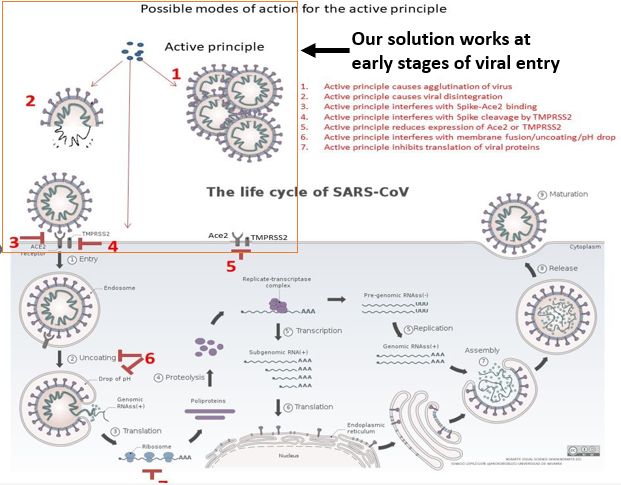Taking an antiviral drug from lab bench to bedside - How to find solution (Chapter 2)
Most antivirals are designed keeping the virus and the cell it infects in mind. We desire to discover and develop novel antiviral solutions, keeping in mind the need of the infected and their loved ones. At the end of the day, the cells in the lungs or the skin belong to someone. And that someone belongs to their family and friends.

Illustrated using images for lab and bedside from openclipart.org | CC0
Recap: In the last chapter1, I talked about the importance of identifying the problem before you find the solution. I described the problem that I am addressing. In a nutshell, viral diseases infect 100s of millions of people each year. They make them sick and cause discomfort. While some viruses cause mild and acute infections, others can result in long-lasting chronic infections. Some infections can trigger chronic diseases like diabetes, while others can have fatal consequences. Furthermore, there is always a risk of caretakers and loved ones getting infected. For this reason, people isolate themselves when infected with an infectious disease. The sickness and loss of life due to viral infections cause the loss of human resources. Hence, this leads to detrimental effect on the economy, as well. In addition to the existing viral diseases, many more are lurking in the wild. There are pox viruses (recent outbreak of monkeypox), NIPAH, Zika, Ebola, many influenza strains, and other coronaviruses. These have the potential to cause the next pandemic. Nevertheless, there are limited options that people have to fight viral diseases.
Why do we have this problem?
People only have limited options when they contract a viral illness. Our best defence against viruses as of now is vaccines 2. But vaccines are available only for a limited number of viral diseases. Many viruses, such as influenza, often find their way around the vaccines needing vaccines to be updated 3. Or in the case of newly emerging epidemics and pandemics, people have to wait for the new vaccine to be developed. This causes significant loss of life, suffering, and even economic losses, by the time we develop and test the vaccine. The other option to reduce pain and suffering is antiviral drugs. But, most antivirals on the market are either specific for certain viruses or have side effects. Hence, it makes sense to take them only when you know what kind of virus infected you and/or when the benefits outweigh the risks.
Take the example of Covid19. While we waited for the vaccines or tried to develop specific drugs, many lives were lost. Many others suffered the sickness and faced hopelessness. They and their loved ones had to face isolation. They were stressed and had nowhere to go. But if we had a broad-spectrum antiviral, which is safe to use, and effective against multiple viruses, we could have used it as a weapon to treat and prevent infections 4, 5.
What do we need?
Nevertheless, we have a very limited repertoire of such safe and broad-spectrum antiviral solutions available in the market 6. We need a broad-spectrum antiviral drug. We want them to be safe enough to be used as both treatments and as preventive prophylactic measures. This is where I and my team comes in. In today's post, I will describe how we are solving the problem.
How and why can we solve this problem?

Image source | Public Domain.

Ebers Papyrus - one of the earliest documentation containing medicinal plants. CC BY-SA 3.0
Plants to the rescue.
Since the dawn of civilization, people have been using various herbs to treat the ill. People in ancient times did not know what they were dealing with. They did not know that bodies were made of cells. Leave alone knowing about bacteria and viruses. They had no clue about what was in those herbs that seemed to work for them. I sometimes even see my dog chewing on herbs when he has a bad stomach. But unlike animals, humans had language and documenting skills. People documented plants with medicinal properties across many cultures.
In fact, plants have inspired many modern drugs that we use. Take metformin, for instance. Metformin is the most prescribed anti-diabetic drug, with a market of $10 billion. Metformin has its root in the plant called Galega officinalis 7. Similarly, aspirin - the drug we take for blood pressure and headaches, is a modified form of a molecule called salicin, found in the bark of the Willow tree 7. Then there is the cancer drug taxol, derived from Pacific Yew's bark 8. About 40% of the current drugs have their roots in nature. So why not look for a possible solution for antiviral drugs in the documented medicinal plants. Some of these medicinal plants have been documented as anti-fever 9. Probing these plant using modern science, will aid in discovery of new class of drugs. Some of these drugs may have good safety profile and broad-spectrum antiviral activity. In fact, curcumin isolated from a plant known in India as Haldi (Turmeric) has broad-spectrum antiviral properties and a good safety profile 10. However, there are issues with solubility and bioavailability with curcumin 11. Nevertheless, proof of principle which justifies digging deeper into plants for the solution I am seeking already exists.
What are we looking for in the plants and what do we want to target?
There are multiple steps in the viral lifecycle that can be targeted12. The virus starts its life when it gets attached to the host cell. For this, the virus uses the proteins on the virus membrane, which binds to specific proteins on the host cell's membrane. It then injects its nucleic acid (DNA or RNA) into the cell by fusing with the cell membrane or endocytosis (the cell engulfs the virus particle). Once inside, the virus genome (DNA or RNA) starts to produce virus proteins and make copies of itself. The synthesized proteins and genome copies then assemble into new viral particles. The newly formed viruses then exit the cell. They exit either by killing cells or simply popping out of cells without destroying cells (by exocytosis, nanotubes, etc).

Modified from image by Vega Asensio | CC BY-SA 4.0
You can find drugs that can inhibit any of these steps in the virus life-cycle. But I was not interested in finding drugs that target replication or viral genome. Neither I wanted to target protein synthesis. I was specifically interested in hitting the early stages of the viral life cycle. I wanted to find inhibitors for viral entry. To be more specific, I wanted inhibitors that block the infection, without having any major effect on cells. So how did we manage to find those?
The alliance between a cell biologist and a phytochemist
When Covid19 struck the world, we were all in lockdown. There were limited resources and time to work on our own research. However, being from a science background, we had an opportunity to work as a volunteer in setting up a Covid19 testing facility and also to work on Covid19 research (see my previous blog for details). I had experience for over 7 years in developing pseudoviruses for genetic manipulation of cells and animals. And my colleague and now co-founder had experience with developing phytochemistry-based solutions for wound healing. He had a repository of over 100 plants. So we teamed up and developed the pipeline to screen those plants for antiviral solutions.
The pipeline
I developed a specific pipeline that can screen for plant extracts with low to no cytotoxicity and potency to inhibit multiple viral infections. Using my experience in making pseudoviruses, we screened for plant extracts that show antiviral activity against SARS-CoV2-Spike containing virus particles. And also against other pseudotyped viral particles. This ensured that we had broad-spectrum activity and not just anti-coronavirus-specific activity. The plant extracts that showed promise were then tested on the live virus and fractionated to identify the active molecules with antiviral activity. Using this pipeline, we identified 5 plant extracts with robust antiviral activity. And now, we are trying to identify the active molecules.
The antiviral peptides and proteins.
Now what was interesting was one of the plant molecules that showed antiviral activity had the molecular signatures of a protein in NMR. It has been previously shown that our own body produces such proteins called anti-microbial peptides/proteins (AMPs) against many bacterial infections 13. And some of these AMPs also have antiviral activity 14. Even plants produce AMPs in response to bacteria and viruses 15. The AMPs such as LL37 is broad-spectrum and can target the virus molecules. In addition, the cool part about plant AMPs is that they are highly stable. Antiviral peptides and proteins have been proposed as a new class of antiviral therapeutic molecules. And we might have found a potential candidate.
Seems like the antiviral AMP that we have identified in this plant is also broad-spectrum, acts on the virus without affecting the cell, and is highly stable.
How can this plant material be turned into antiviral products?
The solution actually takes two forms. One goes via the herbal route and the other via the pharmaceutical route.
The herbal route
Herbal Fast-moving consumer goods
The herbal route is pretty simple. We have standardized the extract and method to enrich it for the active ingredient. We will add this active fraction to the herbal solutions available on the market. It can be used for making daily use products like - herbal disinfectants, sanitisers, soaps, etc. It can also be added to masks to inhibit the virus before it enters our nostrils and mouths.
Herbal nutraceutical solutions
Some nutraceuticals and dietary supplements are already used to boost immunity to fight viral infections 16. Given the plants we identified have already been used in traditional culture, we can add our enriched active principle in nutraceutical and dietary supplements. These nutraceutical and dietary supplements can then be used as a preventive measure or can be given to patients to boost recovery.
Herbal medicines
After testing the enriched active fraction for animal and human safety and efficacy, our formulation can be used to develop herbal drugs containing natural compounds, as a weapon against viral infection. For instance, we can build nasal spray and lozenges to deal with throat and respiratory tract infections. We can make skin ointments for heroes and chickenpox.
The pharma route
The pharma route on the other hand is a long journey but the ultimate goal. This route requires us to synthetically produce the active molecule. Modify if needed to increase safety and efficiency. And then conduct pre-clinical and clinical trials. The successful pharma drug will be developed as an antiviral pill or nasal spray for respiratory and gastric viruses and ointments for akin infections. The aim is to synthesise the active molecule for both treatment and preventive usage.
In a nutshell, we have found a solution from plants for the problem we defined. We found a broad-spectrum, safe and highly stable antiviral molecule,. We now aim to develop various products using it.
In order to stop the overload of information, I guess I will stop for today. I will pick up the next chapter from here. The questions still remaining for the solution are the following:
- Why solution I have in my mind will work?
- Why will people care about my solution and pay for it?
- Is my solution better or different from other solutions? If not is there a need in the market for yet another solution?
- Who will buy it?
I will try to address them next.
Till then have a great week ahead.
 #STEMsocial powered by Hive
#STEMsocial powered by HiveVideo by @gtg
References
Taking an antiviral drug from lab bench to bedside - Defining the problem statement (Chapter 1)
Materials science approaches in the development of broad-spectrum antiviral therapies
Three plant-inspired pharmaceuticals: aspirin, L-DOPA and metformin
Emerging role of nanocarriers to increase the solubility and bioavailability of curcumin
Drug discovery and development targeting the life cycle of SARS-CoV-2
Antimicrobial Peptides: Classification, Design, Application and Research Progress in Multiple Fields
An Overview of Antiviral Peptides and Rational Biodesign Considerations
Plant antimicrobial peptides: structures, functions, and applications
Thanks for your contribution to the STEMsocial community. Feel free to join us on discord to get to know the rest of us!
Please consider delegating to the @stemsocial account (85% of the curation rewards are returned).
Thanks for including @stemsocial as a beneficiary, which gives you stronger support.